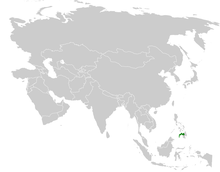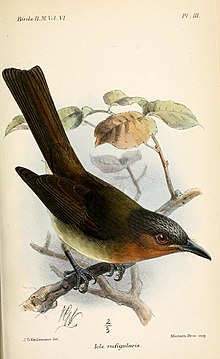| Zamboanga bulbul | |
|---|---|

| |
| Conservation status | |
 Near Threatened (IUCN 3.1) | |
| Scientific classification | |
| Domain: | Eukaryota |
| Kingdom: | Animalia |
| Phylum: | Chordata |
| Class: | Aves |
| Order: | Passeriformes |
| Family: | Pycnonotidae |
| Genus: | Hypsipetes |
| Species: | H. rufigularis |
| Binomial name | |
| Hypsipetes rufigularis Sharpe, 1877 | |

| |
| Synonyms | |
| |
The Zamboanga bulbul (Hypsipetes rufigularis) is a songbird species in the bulbul family, Pycnonotidae. It is endemic to the Philippines, where its natural habitat is tropical moist lowland forests of Basilan and the Zamboanga Peninsula. It is becoming rare due to habitat loss.
Description and taxonomy

EBird describes the bird as "A medium-sized bird of foothill forest and edge in western Mindanao and on adjacent islands. Dark brown above with a grayish-brown streaked crown, a white belly, white under the base of the tail, and a warm reddish-brown throat, cheek, and chest. Note the strong black bill. Somewhat similar to Yellow-wattled Bulbul, but lacks the crest and the obvious yellow eye-ring. Voice includes a loud, pulsing “picha! picha! picha!” followed by medium-pitched warbling."
The Zamboanga bulbul was originally described in the genus Hypsipetes and later placed in the genus Ixos. Formerly, some authorities classified the Zamboanga bulbul in the genus Iole and also considered it to be a subspecies of the Philippine bulbul. In 2010, it was returned to the genus Hypsipetes. It is differentiated by its much larger size and lack of streaking on its throat.
Ecology and behavior
Often observed visiting and feeding on fruiting trees. Pressumed to supplement diet with insects.
Nothing is known about its reproductive behaviour.
Habitat and conservation status
Found in primary and mature secondary forest. It is most common in intact forest.
IUCN has assessed this bird as a near-threatened due to its smaller range. It is still relatively conmmon but forests in the Philippines have experienced rapid habitat destruction.
Found in the protected area of Pasonanca Natural Park but still continues to experience encroachment.
Footnotes
- BirdLife International (2018). "Hypsipetes rufigularis". IUCN Red List of Threatened Species. 2018: e.T22713182A131968765. doi:10.2305/IUCN.UK.2018-2.RLTS.T22713182A131968765.en. Retrieved 18 November 2021.
- BLI (2008)
- "Zamboanga Bulbul - eBird". ebird.org. Retrieved 2024-08-22.
- "Species Version 2 « IOC World Bird List". www.worldbirdnames.org. Retrieved 2017-11-03.
- Fishpool, Lincoln; Tobias, Joseph A. (2020). "Zamboanga Bulbul (Hypsipetes rufigularis), version 1.0". Birds of the World. doi:10.2173/bow.zambul1.01. ISSN 2771-3105.
- Fishpool, Lincoln; Tobias, Joseph A. (2020). "Zamboanga Bulbul (Hypsipetes rufigularis), version 1.0". Birds of the World. doi:10.2173/bow.zambul1.01. ISSN 2771-3105.
- IUCN (2018-08-09). Hypsipetes rufigularis: BirdLife International: The IUCN Red List of Threatened Species 2018: e.T22713182A131968765 (Report). International Union for Conservation of Nature. doi:10.2305/iucn.uk.2018-2.rlts.t22713182a131968765.en.
References
- Gregory, Steven M. (2000): Nomenclature of the Hypsipetes Bulbuls (Pycnonotidae). Forktail 16: 164–166. PDF fulltext
- Moyle, Robert G. & Marks, Ben D. (2006): Phylogenetic relationships of the bulbuls (Aves: Pycnonotidae) based on mitochondrial and nuclear DNA sequence data. Mol. Phylogenet. Evol. 40(3): 687–695. doi:10.1016/j.ympev.2006.04.015 (HTML abstract)
- Pasquet, Éric; Han, Lian-Xian; Khobkhet, Obhas & Cibois, Alice (2001): Towards a molecular systematics of the genus Criniger, and a preliminary phylogeny of the bulbuls (Aves, Passeriformes, Pycnonotidae). Zoosystema 23(4): 857–863. PDF fulltext
| Taxon identifiers | |
|---|---|
| Hypsipetes rufigularis | |
This Pycnonotidae-related article is a stub. You can help Misplaced Pages by expanding it. |